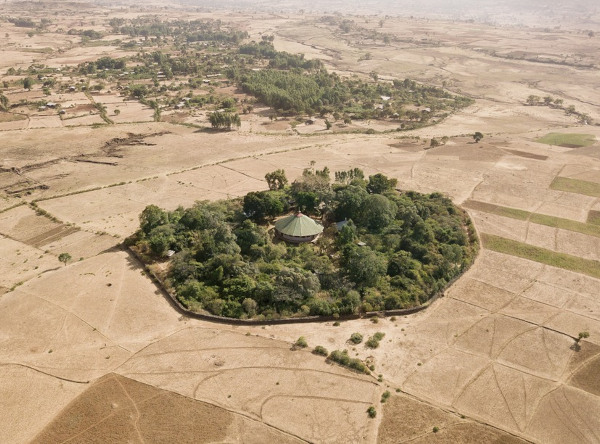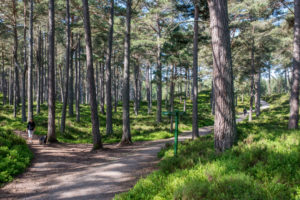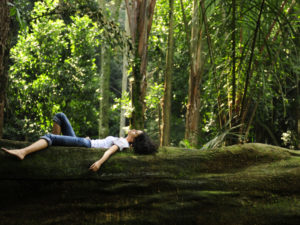Sacred forests of Ethiopia: how they can be recreated anywhere

In these days of gloom and confusion it is good to remember that our world is not ONE continuous story where everything inexorably gets worse – or better – but that our world is full of many stories that are unfolding in parallel. This weekend I was uplifted by the moving account of the holy forests of Ethiopia, their hermits, and the people working to preserve and restore the highland forests to their original glory.
It tells me that the spiritual and the scientific need not be in contradiction, but can be different facets of the quest for integrity if grounded in an appreciation of and care for the living world around us. Referring to the tradition of Ethiopian christianity, forest ecologist Alemayehu Wassie describes these church forests as living arks of plants, people and other animals, with trees as the foundations and hermits as spiritual protectors, both crucial parts of the forest ecology.
This story, told in Emergence Magazine by Jeremy Seiffert and Fred Bahson gives a powerful example of how the human spiritual instinct can combine with scientific understanding in order to create strong protection for the forest and an incentive for its regeneration. Bahson points out that “indigenous cultures like the Orthodox Christian people of Ethiopia have long known is true, that trees are not a green backdrop against which all our vaunted human dramas play out, but actors in their own right, performing what [the Italian novelist] Primo Levi called ‘the solemn poetry of chlorophyll photosynthesis’. And he highlights the crucial role of the hermits as spiritual guardians of the natural world. “The work the menagn of Ethiopia have practiced for at least fifteen hundred years is the quiet, unseen work of intercession. They hide themselves not to escape society, but to pray for the healing of the world, and for that work they are much revered.”
Could a similar thing happen here, or is it already beginning to happen? Where are our sacred forests? How are we protecting and regenerating them? And who is taking responsibility for guarding these shoots of new life?
Forest gardens emerging around the UK and other parts of the post-industrialised western world often start with impulses similar to those that drove Dr Wassie to protect the Ethiopian Church forests. While rarely driven by overtly religious motives, a lot of forest gardeners would admit to some sort of spiritual connection to trees, if that means a bond that goes beyond their mere material benefits. Could we be witnessing the emergence – or renaissance – of a comparable tradition of sacred forests in the secularised, money driven societies of Europe and North America? Robert Hart, UK pioneer of forest gardens, certainly wore his spiritual leanings on his sleeve and detailled them in his final book, Beyond the Forest Garden. So do some of his disciples, such as Janta and Merav Wheelhouse of Karuna in the South Shropshire HIlls. The photo below shows an aerial view of their 17-acre food forest.

In my view it is also significant that forest garden/ food forest pioneers like Robert Hart or Bill Mollison took much of their inspiration from tropical ecologies and cultures, where this connection between daily and spiritual life, human and wider ecology has survived much longer, often to this day. One thing I learned from the article in Emergence is the Aramaic word for forest – cha’ka. Which is close enough to chagga, the name of the indigenous people living in the foothills of Kilimanjaro with a long established practice of multi-story agroforestry, to lead me to suspect that this similarity is more than a coincidence.
A second example of this intertwining of ecology, science and spirituality springs to mind – the work of Treesponsibility in Calderdale, West Yorkshire where for nearly 25 years people have determined to change the landscape from one of very low tree cover (similar to that of the Ethiopian highlands) to a more forested one. Their motto “climate change of a different kind” employed in the first decade of this century also hints at the ambition to change the culture of the valley into one where trees are seen as an integral and fundamental part of the local landscape. Some of the strategies employed to restore the forest are similar – planting along water courses, extension of existing woodland and natural regeneration all play their part. There are also significant differences, such as the focus on large scale tree planting for Treesponsibility. A good argument for this strategy is that personally planting a tree is cited by many volunteers as an act that (re)creates a physical and personal bond with the land that has often lain buried for generations. The Treesponsibility core team is also deeply involved in the politically ecological struggles of our time, from campaigning against open cast mining and fracking to the “We are armed only with peer reviewed science” actions to stop attempts to expand Heathrow airport thirteen years ago, opposed by one Boris Johnson as then mayor of London. Inevitably the activists and their peer reviewed science will return to Heathrow for the next round of this particular battle in the months and years to come.
We will need many living arks (or as permaculture founder David Holmgren calls them, lifeboats), to come through the storms of the 21st century. Forests are the living timbers of those arks. Here are a couple of things you can get involved in to help us make or preserve them:
- Find your nearest local woodland, or if there isn’t one close by, find the nearest overgrown patch of land. Any brownfield site will do. This is how regeneration starts, and this is where you can learn from nature how it’s done.
- Look up your nearest forest garden or permaculture project. In the UK, the best places to find out about them are
- Join up with Treesponsibility, or find your local tree planting group. If there isn’t one in your area yet, Treesponsibility will happily host you at one of their events to show you how it’s done!
These are possible starting points for your own story of connection and regeneration. As many of us feel suspended in time right now, this is as good a time as any to start dreaming that story into being!
The views expressed in our blog are those of the author and not necessarily lowimpact.org's
3 Comments
-
1Lin Scrannage October 20th, 2021
Thank you for reminding us Thomas of ‘the solemn poetry of chlorophyll photosynthesis’. Carbon dioxide is being demonised by society at large – it is easy to forget that it is the lifeblood of our ancient friends.
-
2Dave Darby October 20th, 2021
Hi Lin. We certainly don’t demonise carbon dioxide – just the transferring of it from an underground store laid down over many millions of years to the atmosphere over a couple of lifetimes. That’s a recipe for biodiversity loss, drought, famine, extreme weather events and a lot of suffering for a lot of people. I feel sorry for the next generation.
-
3greencentre October 20th, 2021
Hey, yes, that’s a great quote and from a profound observer of the human condition, in so many different forms. Of course he also used for a deeply moving book’s title, the plea “si no ora – quando?” If not now, then when? For humanity’s sake, for our ecology’s sake, THIS is that time – si no ora, quando?




 For the love of trees: my musings on trees
For the love of trees: my musings on trees
 Becoming a woodland owner: an alternative view
Becoming a woodland owner: an alternative view
 How invasive non-native species threaten our woods and what we can do to help
How invasive non-native species threaten our woods and what we can do to help
 Ancient wisdom to face challenging times
Ancient wisdom to face challenging times
 Forest gardening
Forest gardening
 Nature awareness
Nature awareness
 Nature therapy
Nature therapy
 The 'nature problem'
The 'nature problem'
 Tree / woodland management
Tree / woodland management


